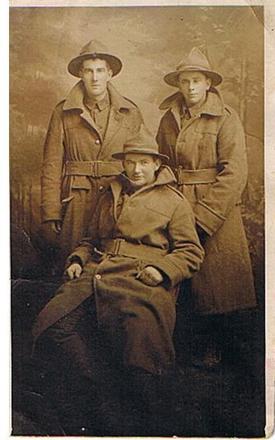Pte
Michael Corcoran
Information about birth
|
Date of birth: 13/01/1894 |
|
Place of birth: Nelson Creek, West Coast, New Zealand |
General information
|
Last known residence: Greymouth, West Coast, New Zealand |
|
Profession: Surveyor |
Army information
|
Country: New Zealand |
|
Force: New Zealand Expeditionary Force |
|
Rank: Private |
|
Service number: 32938 |
|
Enlistment date: 27/07/1916 |
|
Enlistment place: Greymouth, West Coast, New Zealand |
|
Units: — Canterbury Regiment, 3rd Bn. (Last known unit) |
Information about death
|
Date of death: 29/11/1917 |
|
Place of death: Joiners Rest, Beselare, Belgium |
|
Cause of death: Killed in action (K.I.A.) |
|
Age: 23 |
Cemetery
|
Polygon Wood Cemetery Plot: / Row: H Grave: 1 |
Distinctions and medals 2
|
British War Medal Medal |
|
Victory Medal Medal |
Points of interest 4
| #1 | Place of birth | ||
| #2 | Last known residence | ||
| #3 | Enlistment place | ||
| #4 | Place of death (approximate) |
My story
Michael Corcoran was born in 1894 in Nelson Creek, a small settlement at the foot of the New Zealand Alps, inland from Greymouth on the West Coast. He was the son of Thomas and Susan, and one of five children.
In 1916, Michael left his job as a surveyor for the New Zealand government to sign up for military service. He trained for months in New Zealand and England, travelled thousands of kilometres and found himself in the trenches of France and Belgium from May 1917. There he served as company cook in the 3rd battalion of the Canterbury Regiment.
After the Battle of Passchendaele, the New Zealanders found themselves in the Polygon Wood sector. They spent their days wiring the area, repairing crumbling trenches and reinforcing defences in a landscape full of watery shell holes. The Germans held the higher ground, and movements in the New Zealand lines were often spotted and fired upon with machine guns or artillery.
On 29 November 1917, while Michael was cooking for his company in the support lines of Joiners Rest, he was fatally hit by a shell. According to the men who were with him, he remained conscious and even made jokes:
‘I'll see you in Blighty.’
He died a little later. One month before his 24th birthday.
His death hit hard. Ralph Mills, a good friend of Michael's and also from Greymouth, wrote about this in a letter to Michael's sister Cecelia:
‘God, Cis, it was hard to lose him; we were such good friends, and a good friend here is more to a man than a brother. He was always so cheerful, nothing was too much trouble for him and the boys all liked him a lot. He was the most popular cook we had since we came to France.’
Michael was buried in an old German cemetery that the men called the Crucifix, after a large cross that miraculously was still standing upright. Today, that place is called Polygon Wood Cemetery.
In 1916, Michael left his job as a surveyor for the New Zealand government to sign up for military service. He trained for months in New Zealand and England, travelled thousands of kilometres and found himself in the trenches of France and Belgium from May 1917. There he served as company cook in the 3rd battalion of the Canterbury Regiment.
After the Battle of Passchendaele, the New Zealanders found themselves in the Polygon Wood sector. They spent their days wiring the area, repairing crumbling trenches and reinforcing defences in a landscape full of watery shell holes. The Germans held the higher ground, and movements in the New Zealand lines were often spotted and fired upon with machine guns or artillery.
On 29 November 1917, while Michael was cooking for his company in the support lines of Joiners Rest, he was fatally hit by a shell. According to the men who were with him, he remained conscious and even made jokes:
‘I'll see you in Blighty.’
He died a little later. One month before his 24th birthday.
His death hit hard. Ralph Mills, a good friend of Michael's and also from Greymouth, wrote about this in a letter to Michael's sister Cecelia:
‘God, Cis, it was hard to lose him; we were such good friends, and a good friend here is more to a man than a brother. He was always so cheerful, nothing was too much trouble for him and the boys all liked him a lot. He was the most popular cook we had since we came to France.’
Michael was buried in an old German cemetery that the men called the Crucifix, after a large cross that miraculously was still standing upright. Today, that place is called Polygon Wood Cemetery.
Sources 1
|
Ferguson D., The history of the Canterbury Regiment N.Z.E.F. : 1914-1919, (Auckland, Whitcombe and Tombs, 1921) , p 206-208. Sources used |
More information 5
|
Commonwealth War Graves Commission Database https://www.cwgc.org/find-records/find-war-dead/casualty-details/480016 |
|
Namenlijst (In Flanders Fields Museum) https://namenlijst.org/publicsearch/#/person/_id=b02a6b3a-5e3e-4fa0-bf10-7a47a7d410b0 |
|
Lives of the First World War (Imperial War Museum) https://livesofthefirstworldwar.iwm.org.uk/lifestory/7172887 |
|
The NZEF Project (UNSW Canberra) https://nzef.adfa.edu.au/showPerson?pid=53454 |
|
Online Cenotaph (Auckland Museum) https://www.aucklandmuseum.com/war-memorial/online-cenotaph/record/c3169 |
